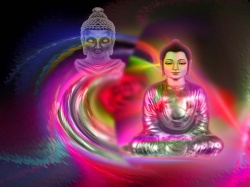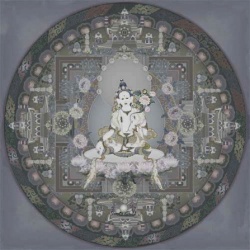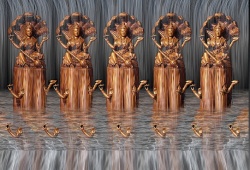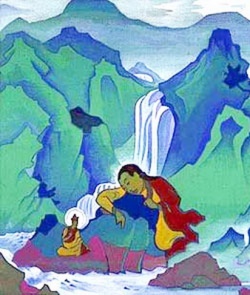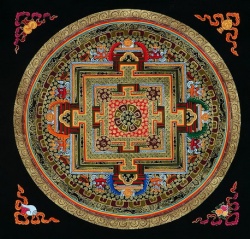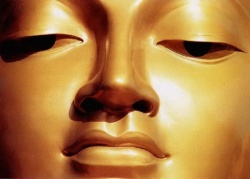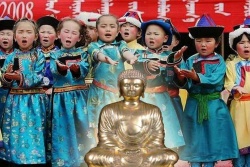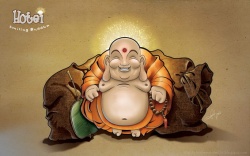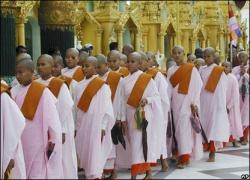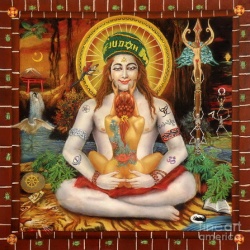Rigdzin Palden Tashi aka Rigdzin Kachupa Palden Tashi
Rigdzin Palden Tashi aka Rigdzin Kachupa Palden Tashi (rig ‘dzin bka ‘bcu pa dpal ldan bkra shis; 1688-1743), born into the Lang family (rlang rus) in Rebkong, one of the four ancient Tibetan families.
He was trained in both the Nyingma and Gelug Buddhist schools.
According to his short autobiography, he took rabchung ordination and vows (rab byung) in 1701, before entering Rongwo Gönchen (thos bsam chos khor gling) to follow basic studies in logic.
He did not limit himself to textbooks however, and by the age of 23, he was ‘pretending’ to study philosophy while practicing deity visualisation and receiving initiations.
By 1712, due to obstacles he begins to practice powerful rituals and finds that they suit him quite well.
Arriving not long after in Central Tibet, he makes a short pilgrimage and decides that he wants to go straight back home, but friends persuade him to stay, and he enters Gomang College in Drepung, to study for another 4-5 years, attaining recognition as promising young scholar-monk or Geshe (dge shes).
Then he sets off on pilgrimage around Ütsang, murmuring discontent between the lines, and feeling that he just wants to practice and meditate.
But once again his fellow monks discourage him, saying it is not a good idea while studying philosophy.
This period coincides with the troubled beginning of the 18th century in Central Tibet.
In 1717, the Dzungar Mongols invade Lhasa on the pretext of avenging the death of the 5th Dalai Lama’s regent, Desi Sangye Gyatso, killed in 1706 by the rival Qoshot Mongols.
The awful violence of the attack, the pillaging of Lhasa, the destruction of two major Nyingmapa monasteries, Dorjedrak and Mindroling, and the beheading of several leading Nyingmapa masters, revolts the population and Palden Tashi as well.
He falls sick and goes to visit Nechung and Gawadong, the two main oracles of Tibet.
They tell him to go to Mindroling, which he does for a short while before fleeing to a remote hermitage in Kham, at Srinmo Dzong.
He then embraced the Nyingmapa tradition at Mindroling Monastery and became the disciple of Great Tertön Nyima Drakpa (gter ston nyi ma grags pa; 1647-1710) and of his son Gyalse Orgyen Tendzin (rgyal sras o rgyan bstan ‘dzin;
1701-1727) from whom he received the complete transmission of Nyima Drakpa's Termas.
Civil war breaks out in Central Tibet, and after quite some journeying to and fro, Palden Tashi decides to return to Rebkong.
In the following year, 1727, he establishes the 1900 Dagger-Wielding, White-Robed, Long Haired Yogins of Rebkong (phur thog gos dkar lcang lo can), which are also known as the Community of Many Yogins (sngags-mang).
From then on, till just one year before his death, he travels through upper and lower Rebkong and far beyond, giving initiations, transmissions and instructions, re-establishing the Nyingmapa teachings in the entire region, where they still flourish today.
Thus, he traveled during the period from 1727 to1742, giving teachings to many lay people.
He founded the Nineteen-Hundred Dagger-Wielding White-Robed and Long Haired Yogins of Rebkong as one thousand nine hundred (1900) Ngakpa attended his initiation of the 'Eight Herukas'.
He gave each of them a Phurba or ritual dagger as a Ngakpa symbol.
These 1900 Ngakpa became known as the 'Rebkong Ngak-Mang 1900 Phurba Holders'.
Thereby he formed the great group of Rebkong Ngakpa, which is known as Rebkong Ngakmang (reb kong ngags mang).
Through his dedication, thousands of Ngakpa and Ngakma came to Amdo and settled down, building hundreds of homes.
His followers referred to him as the King of the Ngakpa tradition.
This intense teaching activity comes in the wake of the rapid expansion of the [[Gelukpa school}}, as it spreads across Central Asia and into the court of the Manchu emperors in Beijing.
Rigdzin Palden Tashi was pursued at key moments in his life by partisan practitioners, and his death in 1742/43 is surrounded by murky circumstances. Yet he remains unbiased in the Rime (ris med) sense of the term, to the last, as he wrote:
“The sky has no colour. If it has how could it be called sky?
A yogic practitioner has no prejudice, if he has, then how could he be called naldjorpa or yogi?”
Ngakpa Nyida Heruka is a student of both Dudjom Rinpoche Jigdral Yeshe Dorje's daughter, Semo Dechen Yudrön (sras mo bde chen g.yu sgron), and Chönyid Rinpoche.
He was recognized as an emanation of the king of the group of Rebkong Ngakpas, Rigdzin Palden Tashi.
Having studied both Tibetan medicine and the Tibetan Ngakpa tradition, he composed several books on Tantra and medicine, and is the founder of the Ngak Mang Institute.
Adapted from Professor Heather Stoddard, A Short Life of Rigzin Palden Tashi (1688-1743), Cardiff Oct. 2011
Changlung Palchen Namkha Jigme (spyang lung dpal chen nam mkha’ ‘jigs med; 1757-1821) was one of the heads of Rebkong Ngakmang.
In his time, the Rebkong Ngakmang developed into a Southern group called [Nyinta Ngakmang]], and a Northern group called Sribta Ngakmang.
He founded the Kyunggön Ngakpa house, which was the main centre for the Northern group.
He was born a nomad in Changlung, Rebkong (central Amdo).
His father was an accomplished tantric practitioner.
Namkha Jigme was ordained at age twenty-five.
He stayed for eighteen months in intensive retreat and trained in Dzogchen practices.
At age forty-three, he traveled to Kham and met Dodrupchen Jigme Trinle Oser, Khatog Gertse Gyurme Tsewang Chogdrub, Gyalrong Namkha Tsewang Chogdrub, and the third Shechen Rigdzin Paljor Gyatso.
In Riwoche, the seat of Tertön Nyima Drakpa, he met Migyur Phande Gyamtso.
Under the advice of Tsendro Khanchen Rinpoche, a [[Gelug [master]] from Repkong, he went to meet the treasure revealer, the third Khardo Rigdzin Chökyi Dorje, from whom he received empowerments, transmissions, blessings and oral instructions.
In Lhasa, he studied with Jigme Lingpa, Minling Trichen Trinley Namgyal and Olga Nangse Dorje.
At age forty six, he returned to Repkong and gave the monks and lay people of the tantric community the empowerment of the Hundred Supreme Deities, Longchen Nyingtik, the entire transmission of Khardo Rinpoche's pure vision, the revelations of Minling Trichen, and other teachings.
At age forty eight, he travelled again to Ütsang to express his gratitude to the ninth Dalai Lama, the seventh Panchen Lama, Khardo Rinpoche, and other former teachers.
From there, he returned to Kham to see Dodrupchen Jigme Trinle Oser from whom he received many gifts.
Around 1810, he founded Khyunggön Mingyur Dorjeling which followed the tradition of Mindroling and became one of the three main seats of the tantric community in Repkong.
It is here that he established a fifteen-day drupchen ceremony and offered a wooden ritual dagger to each participant, roughly 1,900 yogins who were living and practicing in there at the time.
Since then, this community has became known as the Repkong One Thousand Nine Hundred Ritual Dagger Holders.
Namkha Jigme is said to have performed many miracles and revealed several treasures such as a footprint of Padmasambhava on a flat stone and a self-arising statue of Songtsen Gampo.
His life was prophesized by Padmasambhava with the words, “In the future, in the land of Domed, where the rivers cross, my blessed son, with the name of Namkha, will be born.”
Namkha Jigme passed away in 1821.
Among his students were Pema Rangdol and Chöying Tobden Dorje.
Three reincarnations were later identified in Khyunggön, Gurong, and Adarchaga.
Lama Tharchin Rinpoche's seat in Rebkong is the Khyunggön Mingyur Dorjeling.
Nyang Nangse Dorje (nyang snang mdzad rdo rje; 1798-1874) was born in the hamlet of Nyang in Rebkong (reb kong), Amdo.
His father, a tantric practitioner, was Tsering Dhondup (tshe ring don grub), and his mother was Nyingmo Jam (snying mo byams).
After offering some incense to the deities, an uncle named Kunchok (dkon mchog) who was an accomplished tantric practitioner, gave the new born child the name Pema Wangyal (pad ma dbang rgyal).
He had two younger brothers.
Nangse Dorje's favorite childhood game was to pretend to make torma from soil or dung.
Sometimes, he would imitate his father and recite mantra or he would draw effigies of people he disliked and hope that his ritual performance would have an effect on them.
His two uncles were his first teachers with whom he learned to recite and memorize prayers and sacred texts.
From his maternal uncle Guru Dorje (gu ru rdo rje) he learned how to make torma and ritual details.
From a monk called Chogden (mchog ldan) and from the scribe Kharlo (mkhar lo), he learned to write.
When he was eight, Nangse Dorje met Pema Rangdol (pad ma rang grol, 1786-1838) and received from him his first transmission of the preliminary practices and long-life practice.
Pema Rangdol then gave him a yellow protective knot and said: “This child will become a good practitioner.” This is said to be an auspicious sign of being accepted as his disciple.
At the age of eleven, Nangse Dorje was in the audience of a teaching given by Changlung Panchen Namkha Jigme ([[spyang lung dpel chen] nam mkha' 'jigs med]], 1757-1821) in Sho'ong Laka, Rebkong.
From this master, he received the transmissions of the Prayer Which Fulfills All Aspirations (bsam pa lhun grub ma), the Activity Tantra for Avalokiteshvara (bya rgyud thugs rje chen po), and so forth.
When he was thirteen years old, Nangse Dorje he received from Khunglung Repa Damzig Dorje (khyung lung ras pa dam tshig rdo rje, d.u.) many teachings such as the entire empowerment and
teachings of the Longchen Nyintik (klong chen snying thig), the Empowerment of Jetsun Mila (rje btsun mi la'i dbang) and the transmission of The Seven Chapters (le'u bdun ma), a popular prayer to Padmasambhava.
Damzig Dorje then advised to him not to stay in a monastery but to be a good hermit.
He took this advice and later in life was known by his contemporaries as the Hermit of Nyang (nyang gyi mtshams pa).
Nevertheless, at the age of fifteen, he took his monastic vows and was given the name Tenzin Gyatso (bstan 'dzin rgya mtsho).
Ten years later, he was fully ordained.
Around the age of eighteen, Nangse Dorje started to serve as scribe for Pema Rangdol, his root guru.
Later, when Zhabkar Tsogdru Rangdol (zhabs dkar tshogs drug rang grol, 1781-1850), an influential figure within the Rebkong tantric practitioners community (reb kong sngags mang), returned from U-Tsang in 1829, Nyang Nangse Dorje went for an audience.
Shortly afterwards, he started to collect and write down the works of Zhabkar, beginning with The Torch that Illuminates the Graded Path (lam rim gsal ba'i sgron me).
It was Zhabkar who told him to write down the biography of Changlung Panchen Namkha Jigme.
When he finished with that biography, Changlung Panchen appeared in his dream and said to him: “I have in my possession two volumes of my life story, but your one-volume version is fine.
I am happy that you have written it down. You should later also tighten the rules of the tantrika community.
As a gift, I will now bestow on you the accomplishment of swift-footedness.”
Among his other teachers were Serkhang Dorje Chang (gser khang rdo rje 'chang. d.u.) and Magsar Kunzang Tobden Wangpo (mg gsar kun bzang stobs ldan dbang po, 1781-1832).
Nangse Dorje dedicated his later life to teaching and spreading the works of Zhabkar and other masters by giving empowerments, transmissions and advice to the tantrika and lay community.
He also established the drubchen (sgrub chen) ceremony in many villages, and, whenever necessary, he tightened the rules and code of conduct of the tantrika community.
Nangse Dorje was also instrumental in banning the sacrificing of animals during certain rituals in some villages of Rebkong.
Nangse Dorje's work was not only limited to writing down or editing the works of Zhabkar and other masters.
He himself composed an autobiography, one volume of spiritual songs, one volume of rules and regulation on the proper dharma conduct, many ritual texts and supplication prayers.
Indeed, one of his most important contributions is his remarkably detailed autobiography, from which we can glimpse an insight into the life of a tantric practitioner of that particular time and place.
At the age of seventy-seven, on the 3rd day of the 11th month of the wood dog year, 1874, Nyang Nangse Dorje passed away with his face turned south-west, cross-legged, and the two hands in earth-pressing and meditation gesture.
It is said that around the same time, a flash of bright light came from the east and vanished into the west.
Among his students were the second Zhabkar, Jigme Tekchok Tenpa Gyeltsen ('jigs med theg mchog bstan pa rgyal mtshan, 1852-1914), the second Changlung (spyang lung sprul sku, 1822-1858), and Gurung Tulku Natsog Rangdol (dgu rong sprul sku sna tshogs rang grol, 1822- 1874)
Sources:
Lce nag tsang hum chen & Ye shes 'od zer sgrol ma, eds. 2004. “Nyang skyes snang mdzad rdo rje'i rnam thar rin chen phreng ba”.
In Reb kong sngangs mang gi lo rgyus phyogs bsgrigs, p. 835-885. Beijing: Mi rigs dpe skrun khang.
Lce nag tsang hum chen & Ye shes 'od zer sgrol ma, eds. 2004. “Gsang chen bstan pa'i gsal byed rje btsun snang mdzad rdo rje rin po che'i sku tshe tha me'i rnam thar byung tshul ut+pela'i chun po”.
In Reb kong sngangs mang gi lo rgyus phyogs bsgrigs, p. 886-904. Beijing: Mi rigs dpe skrun khang.
Hum chen & Nyi zla, eds. 2006. Nyang skyes snang mdzad rdo rje'i gsung rtsom phyogs bsgrigs. Beijing: Mi rigs dpe skrun khang. Dhondup, Yangdon. Forthcoming. “From Hermit to Saint: The Life of Nyang snang mdzad rdo rje (1798-1874)”.
In Ancient Treasures, New Discoveries. PIATS 2006: Tibetan Studies. Proceedings of the Eleventh Seminar of the International Association for Tibetan Studies, Bonn, 2006. eds. H. Diemberger and K. Phuntsho. Leiden: Brill. Yangdon Dhondup April 2010
